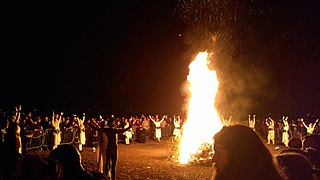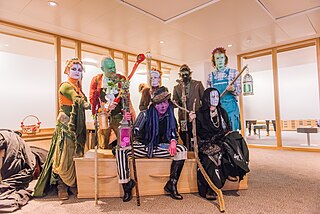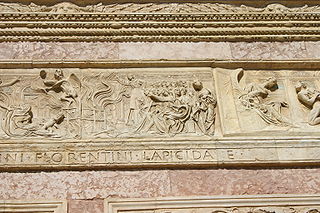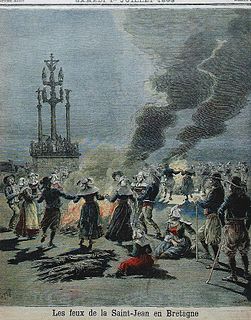| Look up luminaria in Wiktionary, the free dictionary. |
Luminaria and similar terms may refer to:
| Look up luminaria in Wiktionary, the free dictionary. |
Luminaria and similar terms may refer to:
| This disambiguation page lists articles associated with the title Luminaria. If an internal link led you here, you may wish to change the link to point directly to the intended article. |

Beltane or Beltain is the Gaelic May Day festival. Most commonly it is held on 1 May, or about halfway between the spring equinox and the summer solstice. Historically, it was widely observed throughout Ireland, Scotland, Cornwall and the Isle of Man. In Irish the name for the festival day is Lá Bealtaine, in Scottish Gaelic Là Bealltainn and in Manx Gaelic Laa Boaltinn/Boaldyn. It is one of the four Gaelic seasonal festivals—along with Samhain, Imbolc and Lughnasadh—and is similar to the Welsh Calan Mai.

Samhain is a Gaelic festival marking the end of the harvest season and the beginning of winter or the "darker half" of the year. Traditionally, it is celebrated from 31 October to 1 November, as the Celtic day began and ended at sunset. This is about halfway between the autumn equinox and the winter solstice. It is one of the four Gaelic seasonal festivals, along with Imbolc, Bealtaine and Lughnasadh. Historically, it was widely observed throughout Ireland, Scotland and the Isle of Man. Similar festivals are held at the same time of year in other Celtic lands, for example the Brittonic Calan Gaeaf, Kalan Gwav, and Kalan Goañv.

A bonfire is a large but controlled outdoor fire, used either for informal disposal of burnable waste material or as part of a celebration.
Midsummer is the period of time centered upon the summer solstice, and more specifically the northern European celebrations that accompany the actual solstice or take place on a day between June 19 and June 25 and the preceding evening. The exact dates vary among different cultures. The celebration predates Christianity, and existed under different names and traditions around the world.

A bonfire of the vanities is a burning of objects condemned by authorities as occasions of sin. The phrase usually refers to the bonfire of 7 February 1497, when supporters of Dominican friar Girolamo Savonarola collected and burned thousands of objects such as cosmetics, art, and books in Florence, Italy on the Shrove Tuesday festival.

Saint John's Eve, starting at sunset on 23 June, is the eve of celebration before the Feast Day of Saint John the Baptist. The Gospel of Luke states that John was born six months before Jesus; therefore, the feast of John the Baptist was fixed on 24 June, six months before Christmas according to the old Roman calculation. This feast day is one of the very few saints' days which commemorates the anniversary of the birth, rather than the death, of the saint being honored.

The Aggie Bonfire was a long-standing annual tradition at Texas A&M University as part of the college rivalry with the University of Texas at Austin. For 90 years, Texas A&M students—known as Aggies—built a bonfire on campus each autumn, known to the Aggie community simply as "Bonfire". The event symbolized Aggie students' "burning desire to beat the hell outta t.u.", a derogatory nickname for the University of Texas.
The Bonfires of Saint John are a traditional and popular festival celebrated around the world during Midsummer, which takes place on the evening of 23 June, St. John's Eve. It is customary in many cities and towns in Spain; the largest one takes place in Alicante, where it is the most important festival in the city. The biggest celebration in Portugal is held in Oporto, where it is known as the Festa de São João do Porto. In South America, the biggest celebration takes place in the northeastern states of Brazil, where it is known as Festa Junina.

Golowan is the Cornish language word for the Midsummer celebrations in Cornwall, UK; widespread prior to the late 19th century and most popular in the Penwith area and in particular Penzance and Newlyn. The celebrations were centred on the lighting of bonfires and fireworks and the performance of associated rituals. The midsummer bonfire ceremonies were revived at St Ives in 1929 by the Old Cornwall Society and since then spread to other societies across Cornwall, as far as Kit Hill near Callington. Since 1991 the Golowan festival in Penzance has revived many of these ancient customs and has grown to become a major arts and culture festival; its central event 'Mazey Day' now attracts tens of thousands of people to the Penzance area in late June.

The Federation of Old Cornwall Societies (FOCS) was formed in 1924, on the initiative of Robert Morton Nance, with the objective of collecting and maintaining "all those ancient things that make the spirit of Cornwall — its traditions, its old words and ways, and what remains to it of its Celtic language and nationality". The motto of the federation--as written on their web site--is "Cuntelleugh an brewyon ues gesys na vo kellys travyth", which translated into English is "Gather ye the fragments that are left, that nothing be lost". The motto in the OCS logo is the Cornish phrase King Arthur is not dead. The first Old Cornwall Society was established by Robert Morton Nance in St Ives in 1920.

Gozan no Okuribi (五山送り火), more commonly known as Daimonji (大文字), is a festival in Kyoto, Japan. It is the culmination of the Obon festival on August 16, in which five giant bonfires are lit on mountains surrounding the city. It signifies the moment when the spirits of deceased family members, who are said to visit this world during O-Bon, are believed to be returning to the spirit world—thus the name Okuribi.

A luminaria or farolito is a small paper lantern which is of significance in the U.S. state of New Mexico in southwest United States at Christmas time, especially on Christmas Eve. They are also used in Hispanic culture. These paper lanterns have to some extent replaced the older tradition of the vigil fire luminaria with which they became confused.

San Vicente del Raspeig, or Sant Vicent del Raspeig, is a municipality located in the comarca of Alacantí, in the province of Alicante, Spain, inside the conurbation of Alicante city.

The culture of San Antonio reflects the history and culture of one of the state's oldest and largest cities straddling the regional and cultural divide between South and Central Texas. Historically, San Antonio culture comes from a blend of Central Texas (Southern) and South Texas (Southwestern) culture. Founded as a Spanish outpost and the first civil settlement in Texas, San Antonio is heavily influenced by Mexican American culture due to Texas formerly being part of Mexico and, previously, the Spanish Empire. The city also has significant German, Anglo, and African American cultural influences. San Antonio offers a host of cultural institutions, events, restaurants and nightlife in South Texas for both residents and visitors alike.

San Bartolomé de Pinares is a municipality located in the province of Ávila, Castile and León, Spain, with a population of 627 inhabitants. Only 20 km from Ávila, it has long been important for its livestock.

Camp Rock 2: The Final Jam is a 2010 American musical television film directed by Paul Hoen and a sequel to the 2008 film Camp Rock. The film stars Demi Lovato, the Jonas Brothers, Meaghan Martin, Maria Canals-Barrera, Daniel Fathers, and Alyson Stoner, as well as newcomers Daniel Kash, Matthew "Mdot" Finley, and Chloe Bridges. In the film, a new rival summer music camp, Camp Star, appears and attracts everyone's attention, which could mean the end of Camp Rock.
A luminaria is a traditional small bonfire typically used during Las Posadas, a 9-day celebration culminating on Christmas Eve. The luminaria is widely used in Santa Fe, New Mexico. Luminaria is a loanword from Spanish that entered English in New Mexico.

The White Nights are all-night arts festival held in many cities in the summer. The original festival is the White Nights Festival held in Saint Petersburg, Russia. The white nights is the name given in areas of high latitude to the weeks around the summer solstice in June during which sunsets are late, sunrises are early and darkness is never complete. In Saint Petersburg, the Sun does not set until after 10 p.m., and the twilight lasts almost all night.

Bonfire Night is a name given to various annual celebrations characterised by bonfires and fireworks. The event celebrates different traditions on different dates, depending on the country. Some of the most popular instances include Guy Fawkes Night in Great Britain, which is also celebrated in some Commonwealth countries; Northern Ireland's Eleventh Night, and 5 November in Newfoundland and Labrador. In various parts of Ireland, Bonfire Nights are held on St John's Eve, Bealtaine eve and Halloween. In Scandinavia it is known as Walpurgis Night and in Denmark also sankthansaften. St John's Eve is also a very important celebration in Spain and Northern Portugal. Several other cultures also include night-time celebrations involving bonfires and/or fireworks.
Nathan Felix is a classical music composer from Austin, Texas. He now resides in San Antonio. He is also the band leader for The Noise Revival Orchestra.